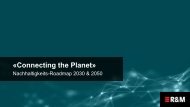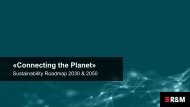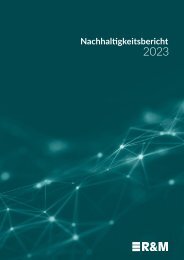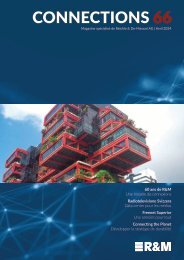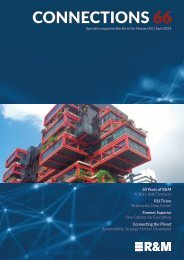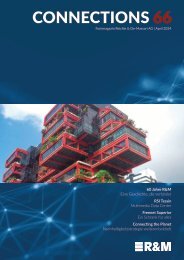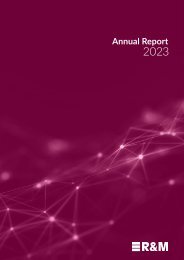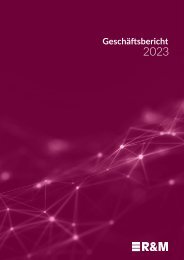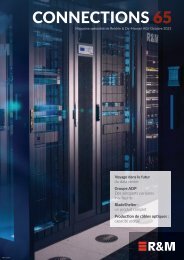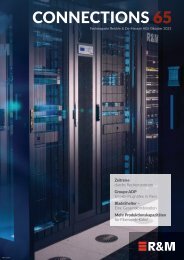CONNECTIONS_53-e
R&M specialist magazine CONNECTIONS no. 53
R&M specialist magazine CONNECTIONS no. 53
You also want an ePaper? Increase the reach of your titles
YUMPU automatically turns print PDFs into web optimized ePapers that Google loves.
Prize 2010) which could prove to be the basis<br />
of even more high-performing electronics in<br />
the future.<br />
But new quantum technologies could also<br />
open up the way for implementing two<br />
technological visions from no less a person<br />
than Richard Feynman: First of all, that it<br />
should be technically possible to manipulate<br />
individual atoms (Feynman 1959). Today<br />
we call this nanotechnology. a technology<br />
which has already been described by many<br />
technological advocates as one of the most<br />
exciting future technologies. Secondly, the<br />
perhaps even more exciting vision of what is<br />
referred to as a «quantum computer» (Feynman<br />
1981). This would be able to process<br />
numerous quantum states, called quantum<br />
bits or qubits, in parallel instead of processing<br />
information bit by bit as is the case with<br />
classical computers. With its help we would<br />
be able to solve problems which are still far<br />
too complex for the supercomputers used<br />
today in physics, biology, weather research<br />
and other areas.<br />
Highly interesting relations<br />
Specifically, quantum computers are based on<br />
the phenomenon of entanglement, probably<br />
the most bizarre phenomenon in the quantum<br />
world: A number of quantum particles can be<br />
brought into a state in which they behave as if<br />
they were linked to each other by an invisible<br />
hand, even if they are a long way away from<br />
each other in spatial and physical terms. Each<br />
particle knows, as it were, what the others<br />
are doing. They all belong to a common<br />
physical entity (physicists refer to this as the<br />
wave function). This results in a correlation<br />
between the particles, enabling an instant<br />
forecast about the state of one particle, when<br />
another particle has been measured - even if<br />
there are lots of kilometers between them.<br />
That is as if somebody in Germany would be<br />
able to sense instantly what was happening<br />
to his or her twin in Australia.<br />
With this kind of collection of entangled<br />
qubits, physicists will be able to operate<br />
simultaneously, or so they hope, on all possible<br />
states. Whereas a normal computer has<br />
to handle all the bits it has to process one<br />
after the other in many, many steps, i.e. from<br />
0 to 1 or 1 to 0, a quantum computer can<br />
process all these steps at the same time. This<br />
high degree of parallelization of operations<br />
increases the computing performance of the<br />
computer exponentially with the number of<br />
qubits, unlike a classical computer working<br />
sequentially, the computing performance of<br />
which increases only linearly with the number<br />
of available computing devices.<br />
Another new quantum technology ensures<br />
the efficient and interruption-free transmission<br />
of qubits: quantum teleportation, in<br />
other words the transport of qubits between<br />
two places. The basis of this technology is<br />
that two quantum particles (e.g. photons) are<br />
entangled into one common quantum-physical<br />
state and then spatially separated without<br />
their common status being destroyed. One<br />
of the particles is sent to the receiver, the<br />
other is superimposed at the transmitter<br />
with the (quantum) information (qubit) to be<br />
teleported. In accordance with the laws of<br />
quantum physics, the state of the distant entangled<br />
particle is determined in a measuring<br />
process at the transmitter automatically and<br />
immediately even though there has been no<br />
direct interaction between the two particles.<br />
The result of this measurement is then<br />
transmitted conventionally to the receiver.<br />
With this information, its qubit can then be<br />
transformed so that it has the same state as<br />
the sender qubit. In this way, the required<br />
(quantum) information was transferred from<br />
the transmitter to the receiver without the<br />
particle being transported physically. With<br />
quantum teleportation, it would seem that<br />
not only the quantum computer but also the<br />
quantum Internet is just around the corner.<br />
Whereas most of us are still struggling<br />
with the epistemological and philosophical<br />
implications of quantum physics, we should<br />
nevertheless pay attention to its ongoing<br />
unprecedented revolutionary technological<br />
future potential. Because this understanding<br />
of the new quantum technologies opens up<br />
a view into the distance - into a future we will<br />
very soon be facing.<br />
090.7272<br />
Olga René Tysyachnyuk Eichenberger<br />
| Project Manager<br />
Synergia Head of Corporate SE, Ukraine<br />
Communications<br />
olga.tysyachnuk@synergia.ua<br />
rene.eichenberger@rdm.com<br />
050.6522<br />
<strong>CONNECTIONS</strong> 10I2017–<strong>53</strong><br />
27




